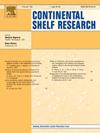Source/sink of CO2 in the southwestern part of Peter the Great Bay (sea of Japan)
IF 2.2
3区 地球科学
Q2 OCEANOGRAPHY
引用次数: 0
Abstract
In this study, the carbon dioxide (CO2) system on the continental shelf of the southwestern part of Peter the Great Bay (PGB), Sea of Japan was investigated during the autumn of 2015. During this season, the PGB represents an ocean-dominated shelf interaction system as the source of nutrients on the shelf is the subsurface part of the Sea of Japan. Weak seasonal upwelling occurred during the study period (October 20–23, 2015), forming a two-layer water structure on the shelf with a sharp pycnocline. The upper warm layer (12–15 °C) is characterized by nutrient depletion and supersaturation of dissolved oxygen concentrations (apparent oxygen utilization (AOU) < 0), and it simultaneously acts as a sink to atmospheric carbon dioxide (pCO2<pCO2atm). The layer beneath the pycnocline is characterized by low temperatures (2–5 °C) and a high concentration of nutrients; it exhibits an oxygen deficit (AOU>0) and an excess of carbon dioxide (pCO2>pCO2atm). Nitrate concentrations in the near-bottom layer of the waters suggest that these waters upwelled to the PGB shelf at depths of 200–300 m in the open Japan-East Sea. We observed a high intensity of photosynthesis corresponding to the pycnocline zone, with chlorophyll a concentration exceeding 10 mg/m3, which was attributed to the phytoplankton bloom. The estimated primary production in the euphotic layer of the southwestern part of PGB is up to 4.98 gC m−2 day−1. Based on the dissolved inorganic carbon (DIC)/nutrient ratio in the subsurface waters of the northwestern Sea of Japan, the shelf becomes a sink for atmospheric carbon dioxide after upwelling. Owing to the heating of surface waters during summer, the PGB acts as a source of CO2 to the atmosphere.
大彼得大帝湾(日本海)西南部的二氧化碳源/汇
本研究于2015年秋季对日本海彼得大帝湾(PGB)西南部大陆架的二氧化碳(CO2)系统进行了调查。在这个季节,PGB代表了一个海洋主导的大陆架相互作用系统,因为大陆架上的营养物质来源是日本海的地下部分。研究期间(2015年10月20日~ 10月23日)发生弱季节性上升流,在陆架上形成两层水结构,具有明显的斜斜。上层暖层(12-15 °C)的特征是养分耗竭和溶解氧浓度过饱和(表观氧利用率(AOU) <; 0),同时作为大气二氧化碳(pCO2<pCO2atm)的汇。斜斜岩下的地层温度低(2-5 °C),营养物质浓度高;它表现出缺氧(AOU>0)和过量的二氧化碳(pCO2>pCO2atm)。近底层水体的硝酸盐浓度表明,这些水体在开放的日本-东海200-300 m深度上涌至PGB陆架。我们观察到与斜斜区对应的光合作用强度高,叶绿素a浓度超过10 mg/m3,这归因于浮游植物的繁殖。在PGB西南部的真光层估计初级产量可达4.98 gC m−2 day−1。根据西北日本海地下水中溶解无机碳(DIC)/营养物的比值,陆架在上升流后成为大气二氧化碳的汇。由于夏季地表水的加热,PGB成为大气中二氧化碳的来源。
本文章由计算机程序翻译,如有差异,请以英文原文为准。
求助全文
约1分钟内获得全文
求助全文
来源期刊

Continental Shelf Research
地学-海洋学
CiteScore
4.30
自引率
4.30%
发文量
136
审稿时长
6.1 months
期刊介绍:
Continental Shelf Research publishes articles dealing with the biological, chemical, geological and physical oceanography of the shallow marine environment, from coastal and estuarine waters out to the shelf break. The continental shelf is a critical environment within the land-ocean continuum, and many processes, functions and problems in the continental shelf are driven by terrestrial inputs transported through the rivers and estuaries to the coastal and continental shelf areas. Manuscripts that deal with these topics must make a clear link to the continental shelf. Examples of research areas include:
Physical sedimentology and geomorphology
Geochemistry of the coastal ocean (inorganic and organic)
Marine environment and anthropogenic effects
Interaction of physical dynamics with natural and manmade shoreline features
Benthic, phytoplankton and zooplankton ecology
Coastal water and sediment quality, and ecosystem health
Benthic-pelagic coupling (physical and biogeochemical)
Interactions between physical dynamics (waves, currents, mixing, etc.) and biogeochemical cycles
Estuarine, coastal and shelf sea modelling and process studies.
 求助内容:
求助内容: 应助结果提醒方式:
应助结果提醒方式:


